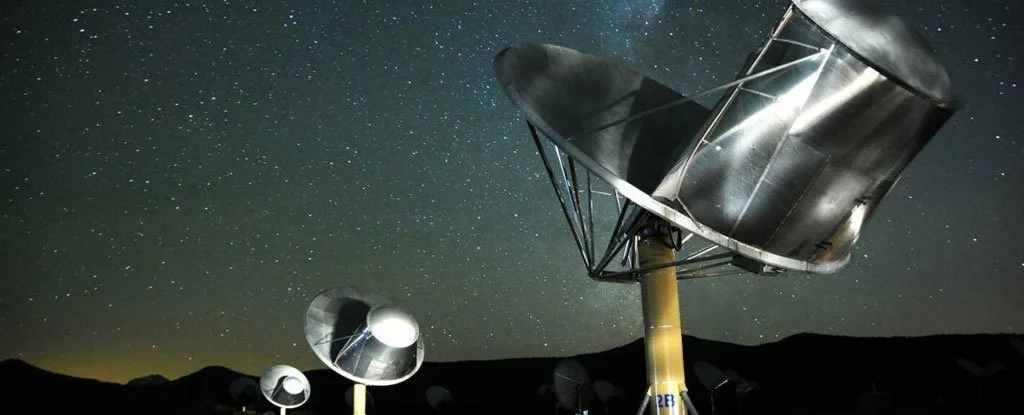Recently, astronomers made a surprising discovery; a mysterious and powerful burst of radio waves has reached Earth after traveling through space for 8 billion years. This burst, called FRB 20220610A, is one of the most distant and energetic radio bursts ever observed. Fast radio bursts (FRBs) are extremely intense bursts of radio waves that last only milliseconds, including this particular burst, but their origins remain a source of great intrigue and curiosity. We still don’t know what or who sent these bursts of energy.
The nature of these signals complicates our understanding of the universe because they may be coming from regions far beyond our own Milky Way galaxy and may point to processes and events that we are only just beginning to understand. Dr. Stuart Ryder, a respected astronomer at Macquarie University in Australia, is one of a team of scientists working diligently to unravel the secrets of this cosmic mystery.
Through advanced technology and collaborative efforts, they aim to decipher the origins and effects of these fast radio emissions, potentially opening new insights into the fundamental workings of our universe and the forces that shape it.
Understanding Fast Radio Signals (FRBs)
Fast radio bursts, or FRBs, are intense bursts of radio waves that last only milliseconds. They were first discovered in 2007 and have since intrigued and fascinated the worldwide scientific community.
For example, this latest FRB released energy equivalent to the energy produced by the Sun in 30 years—in the blink of an eye. The researchers suggest that these cosmic events may be related to magnetars, the high-energy remnants left behind after exploding stars.
Astronomers used the Australian Square Kilometre Array Pathfinder (ASKAP) to detect the burst and trace its origin.
“We used ASKAP radio antennas to try to pinpoint where the explosion was coming from,” says Dr Ryder.
The discovery didn’t stop there. The team also identified the source galaxy with the European Southern Observatory’s Very Large Telescope and found it to be older and more distant than any other FRB source found to date.
“Weighing” the Universe with FRBs
Believe it or not, these fast-moving cosmic fireworks could help us “weigh” the universe. There’s a discrepancy between the amount of normal matter we can detect and what cosmologists theorize should exist. Could the answer lie beyond our visual spectrum?
“More than half of the normal matter that should be there today is missing,” says Professor Ryan Shannon, suggesting that this “missing” matter may be hiding in the vast spaces between galaxies, where it is too hot and diffuse to be seen by conventional methods.
Enter the FRB. Their unique ability to “detect” ionized matter in near-empty space allows scientists to measure the amount of matter found between galaxies. Created in 2020 by the late Australian astronomer Jean-Pierre Macquart, this method is now known as the Macquart ratio.
“This finding confirms the Macquart connection even for flares halfway through the known universe,” Ryder adds.
New telescopes will soon join the search
About 50 FRBs have been traced to their origin, and about half were detected by the ASKAP telescope.
While the causes of these massive explosions are unknown, one thing is certain: FRBs are common events in space and have enormous potential to advance our understanding of the universe.
Professor Shannon believes that future radio telescopes currently under construction will detect thousands more FRBs.
“FRBs are common and promising,” he says. “We can use them to create new maps of the structure of the universe and answer big questions in cosmology.”
The mystery of the missing substance
The universe is vast, and much of it still surprises us, especially the discrepancy between observed and theoretical matter. This “missing matter” is a significant amount that should be present but remains unobserved, according to our current models of cosmic evolution.
Visible matter, such as stars, planets, and galaxies, have been found to make up only about 5% of the total mass-energy mass of the universe. The remaining 95% is considered dark matter and dark energy, which we cannot directly detect. This gap raises some serious questions about the structure and behavior of the universe.
Researchers believe this missing matter may exist in hard-to-see forms, such as hydrogen floating in the intergalactic medium.
Recent studies using advanced telescopes have begun to find these elusive hydrogen clouds, suggesting that much of the matter in the universe may be hiding in this diffuse state.
Figuring out what the missing matter is and where it is is key to getting a full picture of cosmic evolution and fine-tuning our models of how the universe works.
Fortunately, the discovery of FRBs and their ability to track hidden matter could dramatically change our understanding of the universe. As Professor Shannon points out, even in nearly empty space, FRBs can “see” electrons and measure the matter present.
The exciting future of FRB research
With more advanced radio telescopes on the horizon, the future of FRB research looks bright. Each new discovery brings us one step closer to unlocking the secrets of these powerful cosmic events.
In addition to revealing the structure of the universe, FRBs could also lead us to fundamental questions about its inner workings, bringing us closer to the cosmic forces and events that shape our cosmos. Despite our growing knowledge base, FRBs remain one of the universe’s greatest mysteries. As researchers delve deeper into these cosmic explosions, one thing becomes clear: We still know very little about the universe we live in. The full paper is published in the journal Science.













